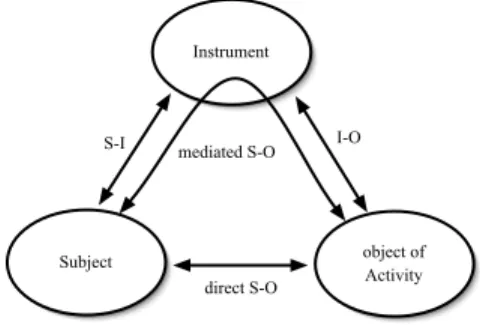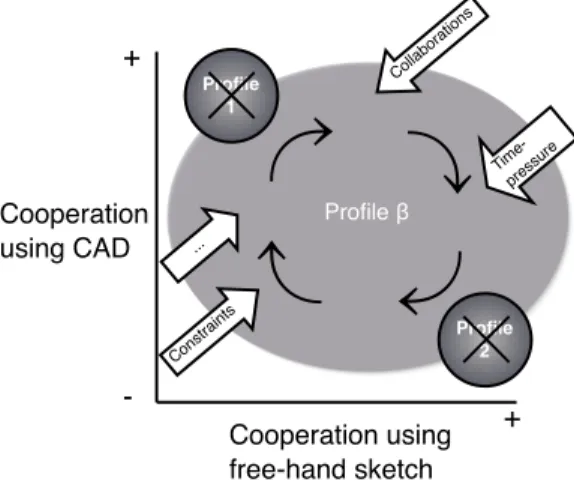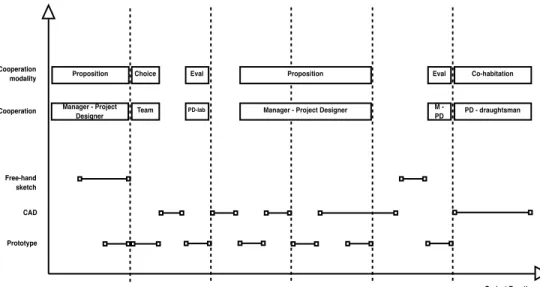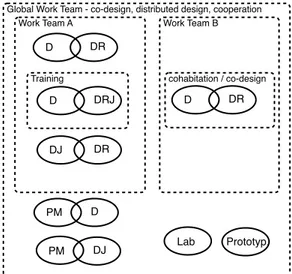An anthropo-based study of industrial design cooperative
practices using “mediating objects”
Catherine Elsen1 and Pierre Leclercq
LUCID-ULg, University of Liège, chemin des chevreuils 1, 4000 Liège, Belgium 1F.R.S.-FNRS Research Fellow (Belgian National Research Fund)
{catherine.elsen, pierre.leclercq}@ulg.ac.be
Abstract. This paper presents a two months in situ case study analyzing the
characteristics of designers’ cooperative work through the use of “mediating objects”. We suggest that the consideration of real and evolutionary practices and everyday complementary work tools helps to understand the various cooperative modalities between co-workers and offers good clues for the development of cooperation support systems.
Keywords: Cooperative design analysis, study of the design tools as cooperative
work support, evolution of industrial design practices.
1 Introduction
Providing designers with more intuitive and user-friendly cooperative design tools or more accurate sketching support systems to support preliminary design are some of the challenges faced by CSCW (Computer Supported Cooperative Work) and SBIM (Sketch-based Interface for Modeling) researchers. Remote cooperative design tasks occasion several challenges we all (researchers, designers, managers, …) try to deal with, such as multiplication of large projects introducing relocated skills, increase of exchanged information volume and need for specific competences to work together even if there are different tools usages and operating methods.
Most of scientific papers facing these difficulties share the same comparative argumentation principle. On the one hand, traditional design tools such as free-hand sketches are said to stay the most powerful support to preliminary design phases but do not easily meet the constraints of remote cooperative design tasks [1; 2 and 3]. On the other hand, it is often argued that CAD tools fail to support ideation [4; 5] but ease long-distance communication and documents exchanges.
exploited in specific exploratory contexts [6], designers go on with using their traditional “maladjusted” tools (sketches or CAD tools) during their cooperative tasks. They rarely take advantage of alternative solutions issued from research, supposed to constitute a better support to the preliminary distant design phases, and deal with their every-day tools’ inadequacies.
To solve what appears to be a paradox, we suggest to study the cooperative design practices with another standpoint. This standpoint combines an anthropo-based approach of real industrial practices and the study of the “mediating objects”. The hope is that the better understanding of these “basic” cooperative characteristics (that is, working in presence of others using every-day complementary tools) will lead to the definition of more coherent and effective remote cooperative support systems, closer to real practices and their current evolutions.
2 Theoretical Framework
Three theories structure our research. First the anthropo-based approach addresses the real practices and replaces the human being at the core of the design research. We secondly focus on “mediating objects” (extending the traditional design tools to their linked external representations) through the application of the instrumental theory [7; 8]. Finally, we suggest, as third theoretical basis, to undo the common comparative approach of cooperative tasks using “sketch or CAD tools”. We argue that this study of “mediating objects” complementarities is in benefit of cooperation tools improvements.
2.1 The “Anthropo-based” Standpoint
Comprehensive Ergonomics provide sound methods to conduct empirical in situ studies and to adopt a multi-disciplinary point of view to understand the actors of design activity. Without being restricted to the single “end-user” of an application, this scientific approach allows us to study all enclosed profiles, to define the real and prescribed tasks, the strategies, the required competences, ... that could impact the cooperative modalities. This discipline is on top of that well adapted to the logic of business, reliability, productivity and competition inherent in cooperative design environments [9].
These observations, interviews and analysis methods help us to take into consideration two major elements. First the impact of new technologies: since CAD tools are unavoidable in every-day design practices, we should evaluate how designers are able to adapt their cooperative work and competences in regard to what constituted their previous habits, and on the other hand how they adapt their tools to the cooperative context. The introduction of new technologies can constitute a positive dynamic on condition of a
correct appropriation and compatibility with design actors’ cognitive modes [10; 11; 12]. Secondly there is a need to put forward the context [13; 14], and we would even emphasize the multiplicity of elements to be considered by putting it in the plural: working contexts, cooperating contexts, physical environments or project types.
2.2 The Focus on “Mediating Objects”
Among all the possible approaches of human cooperation, there is the theoretical framework of instrumental theory that suggests that any type of activity (and, by extension, cooperative ones) is mediated through the usage of artifacts [15]. This theory, developed by Rabardel and Vérillon [7] in Piaget’s theories tradition, introduces the notion of instrument as the combination of an artifact (material, symbolic, cognitive, or semiotic) and one or more associated schemes. The artifact can be commonly defined as the physical part of a tool. The scheme, on the other hand, is the result of “a construction specific to the subject, or through the appropriation of pre-existing social schemes” [16]. The example usually given is the hammering scheme, ordinarily associated with a hammer, but which could in case of necessity be adapted to a shifting spanner.Both sides of the instrumental entity (the artifact and its utilization scheme(s)) act together as the mediator between the subject and the object of his activity (fig 1) [16].
Fig. 1. The IAS Model, “Instrumented Activity Situation”, and its three poles: the subject, the
activity, and the mediating instrument (i.e. an artifact and an utilization scheme).
As our interest is to put forward the new characteristics of designers cooperative work through the use, the sequence of use and the modifications of “objects” inputs, we will define here
(i) the “object of the activity” as the “act of designing together”; (ii) the “subject” much as a group of actors involved in the cooperation;
(iii)the “artifact” part of an instrument as a “mediating object”, extending this way the term and adding to the physical tool (the pen; the computer, the prototyping machine, ...),
Instrument Subject object of Activity S-I I-O direct S-O mediated S-O
the external representation linked to it (respectively the free-hand sketch; the 3D model or print, the physical model, ...). By considering the artifact this way, we try to avoid the general misunderstanding that can occur between “tool” and “external representation”.
2.3 The study of Complementarities
As we underlined before, the established digital design tools inevitably impact cooperative practices and vice-versa. The instruments evolved and conjointly the cooperative modalities between design actors. What could be seen as a paradox - the use of tools that could seem inappropriate - is rather considered here as the human capacity to adapt to a constraining environment, or to deviate the tools from its original use.
Our hypothesis is that several schemes of objects’ use co-exist, and that users deviate them when necessary, depending on the cooperative environment. As figure 2 shows, there wouldn’t be two opposite profiles of designers working in dichotomous worlds and using dichotomous schemes, but alternatively a flexible mid-way profile taking advantage of the objects’ diversity and complementarities (in regard to the appearing constraints and the cooperative contexts).
Fig. 2. The undo of the “dichotomous approach” in benefit of the study of complementarities.
This three-phased proposition structures our study of cooperative design evolution inside a particular field, as presented next.
Profile ! Profile 1 -+ + Cooperation using CAD Cooperation using free-hand sketch Profile 2 Constraints Time-pressure Collaborations ...
!
!
3 Case Study
A two months case study afford us to observe in situ a design team (6 designers, 4 draughtsmen) who was in charge of industrial projects in the field of contemporary heating devices development.
3.1 Methodology
The observer was allowed to stay 8 hours a day inside the open-space office to interview the subjects and capture (recording or filming) every step of their current designs as well as the cooperative facts (between the team, between members of the team and extern members such as the CEO or the prototypists).
This in situ intervention presents several advantages:
(i) it avoids the limitations of a non-realistic lab situation by providing the essential contexts elements;
(ii) it allows a qualitative approach of the fine-grained details of the cooperative process that would be ignored in a more quantitative study but still constitute a stumbling block of the whole project rationale;
(iii) it allows a global overview of several projects presenting diverse states of progression (formal, technical and productive), with provides a relatively complete view of the design processes and methods without following a 2 or 3 years complete project. On top of the 8 interviews (based on a semi-directive and retrospective analysis protocol) we selected 5 different products as a basis of study. These projects were selected for their representativeness of the process evolution and the use of mediating objects, for their variety of cooperative modalities and the variety of their design rationale (project started a few days earlier; project in design phase; another in pre-production phase; product already on the market but needing some adjustments and a new version of a pre-existing range of products).
3.2 Data Analysis
The data gained (interviews based on retrospective analysis as well as in situ observations) has been coded. The goal of this coding is a step-by-step “track” of cooperative context given the appearing constraints and external representations’ evolution (graphic, numeric and volumetric). The code applies to distinct unit of designing actions. One action is defined as soon as the mediating object changes, a new type of cooperation occurs or each time a shift in design process clearly happens (shift from one support to another, one piece to another, one constraint to another, ...).
This coding scheme is exploited to construct the projects timelines of the 5 selected projects (see fig.3). The X-axis represents the project evolution in time, and represents different time scales since the data proceed from interviews or observations coding. The Y-axis sums up the various variables of the coding scheme, which are the use of one specific kind of tool (free-hand sketch; CAD tool or prototype) in parallel with the modality of cooperation (with whom, for doing what).
Fig. 3. An example of timeline with some variables (non exhaustive listing).
4 Results
Our results underline that
(i) the evolution of the design tools’ use (new or traditional) greatly impacts the cooperative work inside or outside the team and leads to a new kind of cooperation between designers and “designers-draughtsmen”(whose activities are part and parcel of a revalued design activity);
(ii) several modalities of cooperative work co-exist and co-evolve during a single project. These modalities (co-design, co-habitation, cooperation between various professions, distributed design, ...) depend on work contexts, experience level in design or CAD field, spatial location and hierarchy.
Project Duration CAD Free-hand sketch Cooperation Cooperation modality Prototype
Proposition Choice Eval Proposition Eval Co-habitation Manager - Project
Designer Team PD-lab Manager - Project Designer
M -
4.1 New Practices - New Cooperation
CAD tools are nowadays completely integrated in industrial designers practices, sometimes since preliminary design. Cooperative modalities have been greatly impacted by this shift in design tools’ use.
Indeed, a new kind of cooperative work appears between designers and “designers-draughtsmen”. These draughtsmen are no longer performers of blue-prints or production plans and subordinates to designers, but take part in the design process since the task distribution has evolved. Actually, the 5 timelines showed that designers nowadays sometimes start designing modeling a 3D rough model instead of using traditional free-hand sketches. On the other free-hand, draughtsmen receiving this rough model go on with more detailed modeling, sometimes discover design errors (such as pieces’ conflicts or production incompatibilities) and suggest solutions through a quick technical sketch1. These backs and returns between design tools, all along the design process, are symptomatic of an effective usage of the tools given their complementarities, which tends to support our “non-dichotomy” hypothesis.
On top of that, this indistinct use of design tools whatever the profession is typical of a deep sharing of competences and sharing of the reference system. The verbatim suggests that co-workers are aware of this phenomenon and fit their cooperative modalities to ease each other procedures. For instance, designers adapt their representations (in content and in aspect) to communicate with draughtsmen that, on the other hand, learn how to interpret in essence the drawings or rough 3D models they receive, presenting heating devices technological details.
We also observed that involved partners always tend to cooperate using the external representation the closer to their shared system of reference. For instance, two designers will cooperate on a drawing (fig 4); a designer and a draughtsman will point out on a screen; designers and prototypists will work on prototypes. Finally, our observations proved that design actors sometimes transform their mediating objects to fit the cooperative situation (see in fig. 5 an example of catachresis phenomenon: the prototype is diverted from its primary goal to be used as a drawing support).
1
There is consequently a need to distinguish “rough” sketches and “rough” CAD models or representations (that stay ambiguous and support ideation), from “technical” sketches and “detailed” CAD models that focus on a more specific sub-problem. The “rough” CAD models or representations are characterized by simple 3D primitive forms, very quickly created without taking care of real dimensions and proportions and that, as rough sketches, support the rapid evaluation of more formal or functional ideas.
Fig. 4 and 5. An example of cooperation between two designers (fig. 4) and the catachresis
phenomenon (fig 5).
4.2 Modalities of cooperative work
The projects’ timelines and the in situ observations suggest that several modalities of cooperative work co-exist and evolve during a project. These modalities are impacted, in this particular situation, by geographic localization and actors’ expertise levels in the design field or use of CAD tools.
Fig. 6. Synthesis of the team’s cooperative modalities. D = Senior Designer; DJ = Junior Designer;
DR := senior draughtsman; DRJ = junior draughtsman and PM = Projects Manager. Global Work Team - co-design, distributed design, cooperation
Work Team A Work Team B
cohabitation / co-design Training DJ DR D DR D DRJ PM DJ PM D D DR Lab Prototyp.
The figure 6 briefly presents the geographic localization of the design team, the common binomial of co-workers with their respective specificities as well as the cooperation modalities we have observed. The global team is split in two open-spaces: the first work-team (A) is composed by two senior designers; one junior designer; two senior draughtsmen and one junior, while the work-team (B), on the other hand, is composed by one senior designer and one senior draughtsman. In other offices stand the Projects Manager, the fire laboratory team and the prototypists.
Both team cooperates everyday, and inside their cooperative work we find:
• Co-design and distributed design, where two partners share the same expertise levels (respectively in heating design field and CAD tools) and effectively cooperate during the whole design process (for instance between D and DR, team A). Allocation of tasks and short briefings are enough to make them match their ideas and work in an efficient way;
• Training, where a senior design, with good competences in 3D modeling, teaches to a junior draughtsman how to deal with the specific technologies of heating devices (D and DRJ in team A);
• Training again, but in a different way, when a junior designer asks for some advices to a senior draughtsman which has become very competent in the field of heating devices development (DJ and DR, team A);
• Co-habitation, finally, between senior designer and draughtsman that both are experts in 3D modeling and “share” a modeling task on a single file. They have to totally re-organize their way to cooperate to work together, from distant computers, on the same 3D object (D and DR, team B).
Outside the team, other types of cooperative work occur between designers/draughtsmen and the lab team or the prototypists. They constantly have to synchronize to adapt themselves to others point of view, given their various competences. The Project Manager finally, himself designer, shows different ways of cooperating with a designer or a draughtsman. Being less available, he shares very quickly with the team always using the most effective cooperative interface: quick sketches with designers; more technical drawings, annotations on prints or interaction on screen (pointing, gestures) with draughtsman.
5 Conclusion and Perspectives
This research, considering its unavoidable sample’s limitations, provides interesting clues for the development of cooperative interfaces that should stay closer to real practices and their evolution.
Indeed, we could resume our findings as follow:
• First, there is a need not to only focus on “obvious” cooperative and end-user actors, but to widen our field studies to all practitioners that impact in a certain way the cooperation. There aren’t dichotomous profiles but flexible ones, actors adapting their work habits to the contexts;
• Second, we should take practices’ evolutions into account and constantly measure, in situ, the real work habits. Ergonomics provide researchers sound methods to analyze different profiles and various contexts in order to dedicate efficient specifications;
• Third, there is a need to consider various levels of experience and expertise and to evaluate their impacts on cooperation. Even if this consideration could seem hardly exploitable for designing support tools, it still reveals the way contemporary designers nowadays deal with CAD tools, also as a cooperative support;
• Finally, instead of focusing exclusively on one cooperative channel (i.e. asynchronous data exchanges; virtual communication through avatars, …), we suggest to consider all tools involved in every-day work habits and to study their complementary uses. Work actors constantly deviate and “misuse” them, adapt them to the constraints of their cooperative tasks, and enlarge the common boarders of what we usually call the “preliminary design phase” and its “traditional tools”.
We believe that all these facts entertain a tremendous amount of potentialities for the development of cooperative support systems. In the field of industrial design, there is naturally an urgent need to analyze other teams and other processes before reaching this goal.
References
1. Goel, V.: Sketches of Thought, Bradford MIT Press, Cambridge (1995)
2. Cross, N.: Strategies for Product Design, Third Edition. Nigel Cross. The open University, Milton Keynes, UK, Ed. Wiley (2000)
3. Visser, W.: The cognitive Artifacts of designing. London, Ed. Lawrence Erlbaum (2006) 4. Whitefield, A.: An analysis and comparison of knowledge use in designing with and without
CAD. In A. Smith (Ed) Knowledge engineering and computer modelling in CAD. Proceedings of CAD86. Seventh international conference on the computer as a design tool. London, Butterworths (1986)
5. Ullman, D.G., Wood, S. and Craig, D.: The importance of drawing in the mechanical design process. NSF engineering design research conference (June) (1989)
industrial context. Cooperative Design, Visualization, and Engineering, 6th International Conference CDVE 2009, Proceedings. Series “Lecture Notes in Computer Science”, Subseries “Information Systems and Applications”, Springer (2009)
7. Rabardel, P.: Les hommes et les technologies, approche cognitive des instruments contemporains. Paris : Armand Colin (1995)
8. Béguin, P., Rabardel, P.: Designing for instrument-mediated activity - Scandinavian Journal of Information Systems (2000)
9. Dejean, P.-H. and Naël, M. : Ergonomie du produit. In Falzon, P., Ergonomie, PUF, pp 463-477 (2004)
10 Caroly, S. : Les mutations du travail face aux défis technologiques: quelles incidences sur la santé ?. Pistes, Vol 9 n° 2 Octobre (2007)
11 Borillo, M., Goulette, J.P. : Cognition et création, explorations cognitives des processus de conception. Mario Borillo et Jean-Pierre Goulette, Belgique, Ed. Mardaga (2002)
12. Lebahar, J.-C. : La conception en design industriel et en architecture. Désir, pertinence, coopération et cognition, Eds Lavoisier (2007)
13. Dorst, K. : Viewpoint - Design research: a revolution-waiting-to-happen. Design Studies, 29, pp. 4-11 (2008)
14. Suwa, M., Purcell, T. and Gero, J. : Macroscopic analysis of design processes based on a scheme for coding designers’ cognitive actions. Design Studies, Vol 19, Issue 4, pages 455-483 (1998)
15. Folcher, V. and Rabardel, P. : Hommes-Artefacts-Activités : perspective instrumentale. In Falzon P., “Ergonomie”, PUF, pp 251-268 (2004)
16.Beguin, P. and Rabardel, P. : Designing for instrument-mediated activity - Scandinavian Journal of Information Systems (2000)



